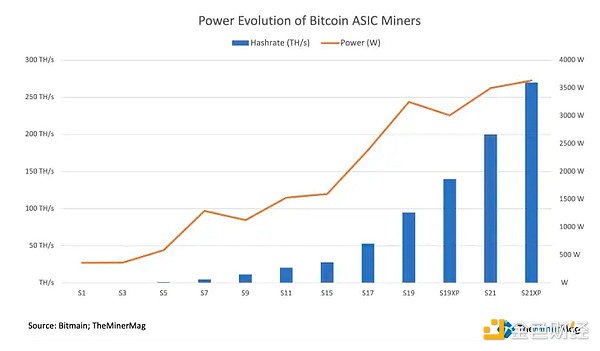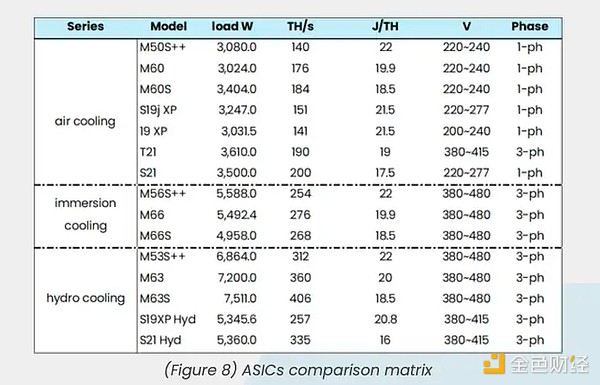Author: Christian Lucas, Bitcoin Magazine; Translator: Baishui, Golden Finance
Since the first ASIC miner was shipped in 2013, Bitcoin mining has grown exponentially, with hardware efficiency increasing from 1,200 J/TH to just 15 J/TH. While these advances have been driven by better chip technology, we have now reached the limits of silicon-based semiconductors. As efficiency increases further, the focus must shift to optimizing other aspects of mining operations - especially power settings.
Three-phase power has become a better alternative to single-phase power in Bitcoin mining. As more ASICs are designed for three-phase voltage input, future mining infrastructure should consider adopting a unified 480v three-phase system, especially given its abundance and scalability in North America.
Understanding Single-Phase and Three-Phase Power
To understand the importance of three-phase power in Bitcoin mining, it is first necessary to understand the basics of single-phase and three-phase power systems.
Single-phase power is the most common type of power used in residential environments. It consists of two wires: a hot wire and a neutral wire. The voltage in a single-phase system oscillates sinusoidally, delivering power that peaks and then drops to zero twice during each cycle.
Imagine you are pushing a person on a swing. With each push, the swing moves forward, then back, reaches its highest height, then drops to its lowest point before you push again.
Just like a swing, a single-phase power system has periods of maximum and zero power delivery. This can lead to inefficiencies, especially when steady power is required, although this inefficiency is negligible in residential applications. However, it becomes significant in high-demand, industrial-scale operations such as Bitcoin mining.
Three-phase power, on the other hand, is commonly used in industrial and commercial settings. It consists of three hot wires and provides a steadier, more reliable flow of power.
In the same swing analogy, imagine three people pushing the swing, but each person pushes at different intervals. One person pushes the swing as it slows down from the first push, another pushes a third of the way through the cycle, and a third pushes two-thirds of the way through. The result is a swing that moves more smoothly and consistently because it is constantly pushed from different angles, maintaining constant motion.
Similarly, three-phase power systems ensure a constant and balanced flow of power, which improves efficiency and reliability, which is particularly beneficial for high-demand applications such as Bitcoin mining.
The Evolution of Bitcoin Mining Power Requirements
Bitcoin mining has come a long way since its inception, and power requirements have changed significantly over the years.
Prior to 2013, miners relied on CPUs and GPUs to mine Bitcoin. As the Bitcoin network grew and competition increased, the development of ASIC (Application Specific Integrated Circuit) miners brought real change. Designed specifically for mining Bitcoin, these devices offer unparalleled efficiency and performance. However, the increased power requirements of these machines necessitated improvements in power systems.
In 2016, top-of-the-line mining machines were capable of computing at 13 TH/s, consuming approximately 1,300 watts (W). While extremely inefficient by today’s standards, mining with such equipment was profitable due to low network competition at the time. However, to generate respectable profits in today’s competitive environment, institutional miners now rely on machines that require approximately 3,510 W.
As the power requirements of ASICs and efficiency demands of high-performance mining operations continued to grow, the limitations of single-phase power systems became apparent. Transitioning to three-phase power became a logical step to support the industry’s growing energy needs.

480V Three-Phase Power in Bitcoin Mining
Efficiency First
480v three-phase power has long been the standard in industrial environments in North America, South America, and elsewhere. This widespread adoption is due to its numerous advantages in terms of efficiency, cost savings, and scalability. The consistency and reliability of 480v three-phase power makes it ideal for operations that require greater uptime and fleet efficiency, especially in a post-halving world.
One of the main advantages of three-phase power is its ability to provide higher power density, thereby reducing energy losses and ensuring that mining equipment operates at optimal performance levels.
In addition, implementing a three-phase power system can result in significant savings in power infrastructure costs. Fewer transformers, smaller wiring, and reduced need for voltage regulation equipment help reduce installation and maintenance expenses.
For example, a load that requires 17.3 kilowatts of power at 208v three-phase requires 48 amps of current. However, if the same load is powered by a 480v source, the current demand drops to just 24 amps. Cutting the current in half not only reduces power loss, but also minimizes the need for thicker, more expensive wires.
Scalability
As mining operations expand, the ability to easily add more capacity without major overhauls to the power infrastructure is critical. The high availability of systems and components designed for 480v three-phase power makes it easier for miners to scale their operations efficiently.
As the Bitcoin mining industry grows, there is a clear trend toward developing more ASICs that comply with the three-phase standard. Designing mining facilities with a 480v three-phase configuration not only addresses current inefficiencies, but also future-proofs the infrastructure. This allows miners to seamlessly integrate new technologies that may have been designed with three-phase power compatibility in mind.
As shown in the table below, immersion cooling and water cooling technologies are superior methods for scaling up Bitcoin mining operations to achieve higher hash rate output. But to support such high computing power, the configuration of three-phase power is essential to maintain similar power efficiency levels. In short, this will lead to higher operating profits at the same profit margin percentage.

Implementing Three-Phase Power in Bitcoin Mining Operations
Transitioning to a three-phase power system requires careful planning and execution. The following are the key steps to implementing three-phase power in Bitcoin mining operations.
Assessing Power Requirements
The first step in implementing a three-phase power system is to assess the power requirements of your mining operation. This involves calculating the total power consumption of all mining equipment and determining the appropriate capacity of the power system.
Upgrading Power Infrastructure
Upgrading power infrastructure to support a three-phase power system may involve installing new transformers, wires, and circuit breakers. It is critical to work with a qualified electrical engineer to ensure that the installation meets safety and regulatory standards.
Configuring ASIC Miners for Three-Phase Power
Many modern ASIC miners are designed to run on three-phase power. However, older models may require modification or the use of power conversion equipment. Configuring miners to run on three-phase power is a critical step in maximizing efficiency.
Implementing Redundancy and Backup Systems
To ensure uninterrupted mining operations, it is critical to implement redundancy and backup systems. This includes installing backup generators, uninterruptible power supplies, and redundant circuits to protect against power outages and equipment failures.
Monitoring and Maintenance
Once a three-phase power system is operational, ongoing monitoring and maintenance are critical to ensure optimal performance. Regular inspections, load balancing, and proactive maintenance can help identify and resolve potential issues before they impact operations.
Conclusion
The future of Bitcoin mining lies in the efficient use of power resources. As advances in chip processing technology reach their limits, paying attention to power settings becomes increasingly important. Three-phase power, especially 480v systems, offer many advantages that can revolutionize Bitcoin mining operations.
By offering higher power density, improved efficiency, lower infrastructure costs, and scalability, three-phase power systems can meet the growing demands of the mining industry. Implementing such a system requires careful planning and execution, but the benefits far outweigh the challenges.
As the Bitcoin mining industry continues to grow, adopting three-phase power can pave the way for more sustainable and profitable operations. With the right infrastructure in place, miners can fully utilize the potential of their equipment and stay ahead in the competitive world of Bitcoin mining.
 JinseFinance
JinseFinance
 JinseFinance
JinseFinance Sanya
Sanya cryptopotato
cryptopotato decrypt
decrypt Bitcoinist
Bitcoinist Coindesk
Coindesk Bitcoinist
Bitcoinist Cointelegraph
Cointelegraph Cointelegraph
Cointelegraph Cointelegraph
Cointelegraph